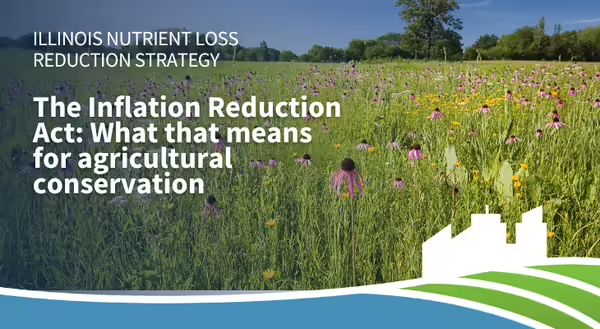
The Bipartisan Inflation Reduction Act (IRA) was signed into law in August 2022. Within the IRA, $18 billion was allocated for agricultural conservation funding over the next 10 years for existing USDA programs. Ivan Dozier, retired Illinois State Conservationist, and Jonathan Coppess, University of Illinois Agriculture Policy Specialist discuss which USDA conservation programs will benefit and how this extra funding may complicate the continued existence of these programs over time.
USDA Programs
The IRA is increasing funding for four existing USDA programs:
- Environmental Quality Incentives Program (EQIP)
- Conservation Reserve Program (CRP)
- Conservation Stewardship Program (CSP)
- Regional Conservation Partnership Program (RCPP)
Dozier explains the EQIP program as the program that helps farmers with existing resource issues from erosion and nutrient management to upgrading livestock facilities. Coppess expands that the EQIP program provides direct cost-share to farmers for conservation practice adoption.
CRP is a longer-term temporary land retirement program taking land out of production and returning it to wetlands or grasslands in 10-year contracts. CRP also protects farmland from urban sprawl.
For farmers who are already practicing conservation, CSP is an important program. Dozier reveals that using CSP allows farmers to continue with ongoing conservation while adding additional practices. Coppess elaborates that CSPs are 5-year annual contracts that the farmer must meet a certain level of conservation to renew and is a way to improve and expand conservation over the life of the contract.
RCPP was created in the 2014 Farm Bill to work across different types of policies and problematic issues, and it combines public and private funding to support conservation practices on-farm. Coppess adds that these programs represent the largest federal investment in conservation on private lands.
Inflation Reduction Act
So, what does this mean? The IRA appropriated large additional amounts of funding for EQIP, CRP, CSP, and RCPP. This additional funding is above the baseline funding outlined in the Farm Bill for these permanent programs.
When asked about a potential backlog of farmers requesting cost-share assistance on conservation practice adoption, Dozier acknowledged that there is a backlog and that these funds will help address that issue. The backlog also shows the high-interest level of Illinois farmers in conservation practice adoption and shows that the funds being given to Illinois will be used wisely. Dozier also suggests that the $18 billion in conservation funding included in the IRA might spawn discussions of new programming, as Congress begins the task of creating the reoccurring legislation referred to as the Farm Bill. One concern regarding the IRA funding would be that some in Congress could use the funding as an excuse to eliminate line items in the 2023 Farm Bill or to reallocate some of the funds away from conservation.
Conservation is bipartisan
Ivan Dozier explains it is exciting to see pieces of legislation that include conservation, especially programs that already have interest with dollars going directly to farmers. He goes on to say that conservation practice adoption is beneficial for everyone because it provides cleaner air and water while supporting a balanced habitat for wildlife. Coppess agrees that conservation is something that everyone supports, and it helps all.
To listen to the full podcast interviews with Ivan and Jonathan and learn about the potential impact of the IRA on the 2023 Farm bill go to go.illinois.edu/NLRS_episode49.
ABOUT THE AUTHORS
Rachel Curry is a Watershed Outreach Associate for two Nitrogen Priority Watersheds (Flint-Henderson and Lower Rock River Watersheds) and is housed in the Galva office of the Henry, Mercer, Rock Island, and Stark Counties Extension Unit. Rachel earned a BS in Environmental Studies from Knox College and an MS in Environmental Science and Soil Science from Iowa State University with an emphasis on soil fertility. She is interested in sharing information on the Illinois Nutrient Loss Reduction Strategy and agricultural conservation practices through discussion and outreach.
Nicole Haverback is a Watershed Outreach Associate for two Phosphorus Priority Watersheds (Embarras and Little Wabash River Watersheds) and is housed in the Effingham office of the Clay, Effingham, Fayette, and Jasper Counties Extension Unit. Nicole earned a BS in Agriculture and Rural Policy Studies from Iowa State University in May of 2022. She is interested in sharing information on the Illinois Nutrient Loss Reduction Strategy and agriculture conservation practices through discussion and outreach.
ABOUT THE BLOG
At Illinois Extension, we’re working to improve water quality at home and downstream. Every month, our watershed outreach associates will bring you stories highlighting agricultural conservation practices, current research projects and results, and from the field farmer interviews. The Nutrient Loss Reduction blog covers conservation practices recommended by the Illinois Nutrient Loss Reduction Strategy, timely updates, farm safety, and new decision tools to help farmers and producers reduce the nutrients leaving their field. Want to get notified when new blog posts are available? Subscribe at go.illinois.edu/SubscribeINLRS.